Regular readers of this blog, or those who are closely following the communications of the HMRC, will be aware that there has been a lot of uncertainty around how one might account for VAT on services after Brexit. Whilst we did a previous article that speculated how services may be treated post-Brexit, the HMRC have finally given us clarity and thus this article will update you on how you should be accounting for VAT on any services you provide from the UK to the EU (or vice versa).
Where Should You Pay VAT On Services
It was previously assumed that little would change, and services supplied from the UK to the EU would be classed as originating in the UK, and thus would be subject to UK VAT.
This is not the case.
In fact, the services will be subjected to the new Use and Enjoyment rules. The use and enjoyment rules are intended to make sure taxation takes place where services are consumed where either services are consumed within the UK but would otherwise escape VAT, or they would be subject to UK VAT when consumed outside the UK.
Effective use and enjoyment takes place where a recipient actually consumes services irrespective of the contractual arrangements, payment or beneficial interest.
The services covered by these rules are:
- the letting on hire of goods (including means of transport)
- electronically supplied services (B2B only)
- telecommunications services (B2B only)
- repairs to goods under an insurance claim (B2B only)
- radio and television broadcasting services.
In short, when supplying a service the supplier will have to pay VAT to the country in which the services are used. This applies both for services supplied from the UK to the EU and services supplied from the EU to UK.
Digital Services
Similar to other services, any VAT on digital services should be paid to the place that they are used, regardless of where they originated.
However, UK suppliers should be aware that they can no longer use the VAT MOSS system. This means that VAT will be due on all EU sales of digital services, regardless of the price as there is no longer a tax threshold on digital services. Find out here how to pay Vat to the EU on digital services.
Suppliers of EU services to the UK should register and account for UK VAT.
Essentially, all of this means that the EU and the UK will just see each other as any other non-member country in the case of services.
Indeed, when a UK service provider is invoicing a non-EU individual for services listed within Value Added Tax Act 1994 (VATA94) schedule 4a, paragraph 16(2), the place of supply is where the individual resides, therefore, outside the scope of UK VAT. See VAT notice 741a sec 12.
Since Brexit (1 January 2021), this has extended to all non-UK consumers, including the EU.
Conclusion – VAT On Services
The main thing to bear in mind is that services are being treated in a very different way to goods by the EU and UK post-Brexit. Whilst the two parties have remained a strong relationship in the trade of goods and have decided that origin of goods is wherever they are produced, they have done the opposite with services and have decided that suppliers must account for tax in the countries that their service is used and enjoyed.
If you are a business who participates in cross border e-commerce and supplies services, we would be more than happy to help you register for VAT, file your VAT returns, and help you comply with VAT in case your account faces any issues. We even offer warehouse storage across in the UK and Europe.
At J&P, helping your business is our passion, and we understand that companies across the UK are at risk now more than ever. We are here to support you through the Coronavirus crisis and Brexit, so please do not hesitate to give us a call on 0161 637 1080 or send an e-mail to enquiries@jpaccountant.com.
